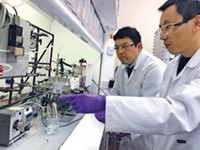Advertisement
Grab your lab coat. Let's get started
Welcome!
Welcome!
Create an account below to get 6 C&EN articles per month, receive newsletters and more - all free.
It seems this is your first time logging in online. Please enter the following information to continue.
As an ACS member you automatically get access to this site. All we need is few more details to create your reading experience.
Not you? Sign in with a different account.
Not you? Sign in with a different account.
ERROR 1
ERROR 1
ERROR 2
ERROR 2
ERROR 2
ERROR 2
ERROR 2
Password and Confirm password must match.
If you have an ACS member number, please enter it here so we can link this account to your membership. (optional)
ERROR 2
ACS values your privacy. By submitting your information, you are gaining access to C&EN and subscribing to our weekly newsletter. We use the information you provide to make your reading experience better, and we will never sell your data to third party members.
Hydrogen Power
Natural hydrogen can be a source of clean energy
A new study provides the first preliminary greenhouse gas estimates for natural hydrogen production
by Priyanka Runwal
July 30, 2023
| A version of this story appeared in
Volume 101, Issue 25
Hydrogen is gaining attention as a low-carbon alternative to fossil fuels. However, most hydrogen produced today comes from a method called steam reformation where high-pressure steam reacts with methane, the main component of natural gas. This method results in high carbon dioxide emissions. Another option is to use energy-hungry electrolysis to separate hydrogen from water. But potentially sizable natural hydrogen reserves in Earth’s crust remain largely untapped. Whether its production will prove climate-friendly is unknown.
In a new study, Stanford University scientist Adam Brandt provides the first preliminary greenhouse gas estimates for natural hydrogen production, indicating its promise as a source of clean energy.
“It’s important work,” says Michael Webber, a clean technology expert at the University of Texas at Austin, “because there are a lot of questions out there about hydrogen [linked] emissions but also about geological hydrogen.”
Brandt used a technique called life cycle analysis to estimate greenhouse gas emissions that occur during various steps involved in obtaining natural hydrogen. He altered a model that makes similar estimates for conventional oil and gas generation and applied it to the processing and purification of hydrogen gas. Accounting for parameters like concentration of the gas, well productivity and depth, and methods of powering the production and handling waste, he found emissions to be as low as 0.4 kilograms of greenhouse gases for every kilogram of hydrogen produced (Joule 2023, DOI: 10.1016/j.joule.2023.07.001).
“The numbers are very impressive,” says Viacheslav Zgonnik, who reviewed the study and is also the CEO of Natural Hydrogen Energy. The lifecycle emissions for natural hydrogen are lower than those for hydrogen produced from several other methods, he says.
The emission estimates, albeit preliminary, were low for scenarios where productive reservoirs hold high concentrations of hydrogen gas and when production is powered by clean energy sources. Brandt suggests revising the analysis once commercial extraction of natural hydrogen commences and real data become available.




Join the conversation
Contact the reporter
Submit a Letter to the Editor for publication
Engage with us on Twitter